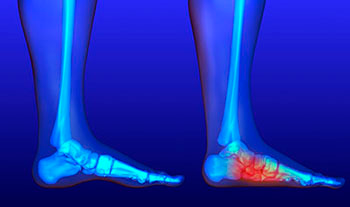Welcome to Tri-County Foot & Ankle
Flat Feet

What are Flat Feet?
Flat feet is a condition – often seen by the podiatrists at Tri-County Foot & Ankle – in which the arch of the foot is depressed, generally making the sole of the foot completely or almost completely stay in contact with the ground. About 20-30% of the population generally has flat feet because their arch never formed during growth. The condition is relatively common in babies and small children as a result of the arch not developing. Adults can develop flat feet as a result of injury, pregnancy or obesity due to increased elasticity. However, in adults it is usually a permanent condition. Those who have health concerns such as rheumatoid arthritis or diabetes may also be at greater risk for developing the condition.
Symptoms
Symptoms can include: pain around the heel or arch area, trouble standing on the tip toe, swelling around the inside of the ankle, having a flat look to one or both feet, and having your shoes feel uneven when worn. Over time, a lot of stress and trauma to the foot can actually weaken the posterior tibial tendon that runs around the inside of the ankle. This is the reason why some people with have pain around that particular area.
Having flat feet can sometimes make it difficult to walk due to the stress it places on the ankles. The general alignment of your legs is thrown off because the ankles move more inward which can cause some major discomfort. This also has a big effect on the knees as many people that have this issue often have arthritis in that area. However, in many cases, having flat feet does not cause any pain and it should not be a cause for concern in that case.
Consulting the Experts
If you suspect that you have flat feet, it is best to consult your TCFA podiatrist. Your foot doctor will examine the suspected foot and observe how it looks while you sit and stand. They may take an X-ray to determine how serious the condition is. Some common signs of flat foot include toe drift, in which the toes and front part of the foot point outward, a short Achilles tendon, and a heel that tilts outwardly while the ankle tilts inward.
Once flat foot has been diagnosed, your podiatrist may suggest one of several treatment options. Flat feet can be rigid, in which the feet appear to have no arch even when the person is not standing; or flexible, in which the person appears to have an arch while not standing, but once standing the arch disappears. Those with flexible flatfoot may be told to reduce any activities that cause pain and to avoid extended periods of walking or standing. Another suggestion may be weight loss, as excessive weight may be placing pressure on the arches.
In few cases, if the condition is severe and all other methods have been exhausted surgery may be required. This is normally avoided, however, due to a lengthy recovery time and high cost.
Advice
People with flat feet need to take extra precautions when it comes to selecting footwear. Although people tend to wear flip flops during the summer, they are not meant for everyday use. Flip flops can be very troublesome for people with flat feet because they do not offer any arch support. Shoes with no arch support may cause the foot to collapse since there is no support. However, there are some flip flops and sandals that offer arch support. These types of shoes should be worn instead because they are not completely flat.
When it comes to runners, there are specific shoes that can help realign the ankles and provide more support while lessening the amount of pronation involved. Running often causes weight shifting very quickly, so it’s important to be informed whether or not you are affected by flat feet.
If you’re suffering from pain related to flat feet, schedule an appointment with us today at 352-259-1919.
